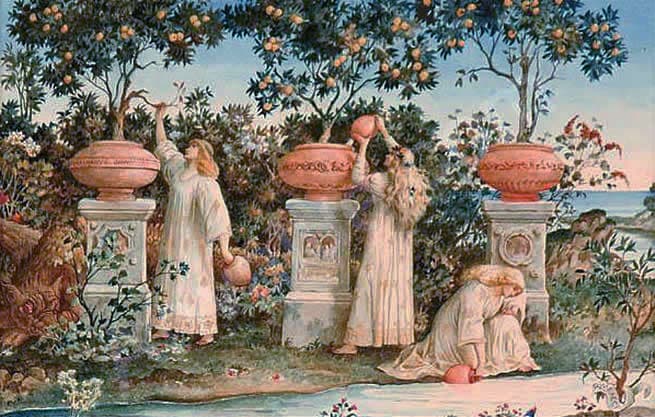In the vast and intricate tapestry of Greek mythology, the Hesperides hold a unique and enchanting thread. These nymphs, often depicted as beautiful maidens, are known for their role as the guardians of the golden apples in a distant, idyllic garden at the edge of the world.
The garden, often referred to as the Garden of the Hesperides, is a place of eternal sunset, where the golden light casts a glow on the nymphs and the precious fruits they protect. The Hesperides are often associated with the evening and the golden light of sunset, embodying the ephemeral beauty of the twilight hours.
Hesperides Key Facts
| Parents | Nyx (Night) |
| Partners | None |
| Siblings | The Moirai (Fates), The Keres, Hypnos, Moros and more. |
| Offspring | None |
| Other names | Nymphs of the Evening |
| Roman name | Hesperides |
| The Goddesses of | The Evening, The Golden Light |
| Symbols | Golden Apples |
Name and Etymology
The name Hesperides originates from the Greek word ‘Hespera,’ which translates to evening. This etymology reflects their association with the evening light and the western direction where the sun sets. The Roman name for the Hesperides remains the same, showcasing a shared appreciation for these ethereal beings across different cultures.
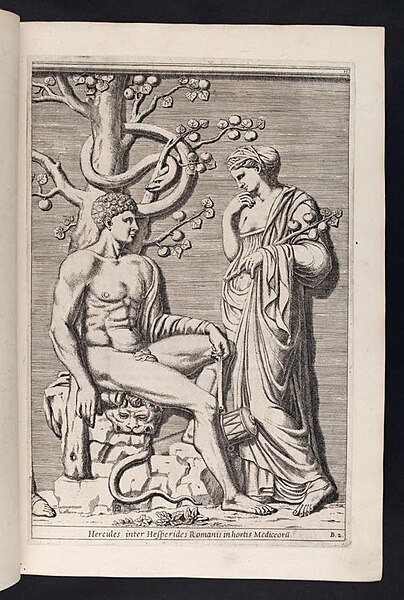
Various epithets and alternative names have been used to describe the Hesperides, often highlighting their role as guardians or their association with the golden apples. They are sometimes referred to as the “Nymphs of the Evening,” a title that encapsulates their essence and the time of day they represent.
The Hesperides’ name and the imagery it evokes have been a source of inspiration across different cultures and eras. The idea of a distant garden, guarded by beautiful nymphs and holding treasures of immeasurable value, has captured the imagination of many, making the Hesperides a lasting part of the mythological landscape.

Hesperides Origins
The Hesperides are primarily believed to be the daughters of Nyx, the personification of night. However, some ancient sources suggest that they might be the offspring of Zeus and Themis. This dual parentage reflects the complex and sometimes contradictory nature of Greek mythology, where beings could have different origins depending on the source.
With Nyx as their mother, the birth of the Hesperides, as with their siblings, is a unique tale. Their mother, brought them into existence without consort, a testament to her primordial and potent nature. Among their siblings are formidable entities like Moros (Doom), Thanatos (Death), Hypnos (Sleep), the tribe of Oneiroi (Dreams), Momus (Blame), Oizys (Misery), the Moirai (Fates), Nemesis (Revenge), Apate (Deceit), Philotes (Friendship), Geras (Old Age), and Eris (Strife). Each sibling represents a different aspect of life’s hardships and inevitabilities, embodying the myriad experiences of the mortal realm.
The Hesperides, as Daemones (Spirits) of the evening, embody the transient beauty of the twilight. Their personification of the evening and the golden light represents a time of day that holds both the promise of the night and the remnants of the day, a liminal space that evokes a sense of mystery and enchantment.
Hesperides Lovers and Relationships
The Hesperides are not particularly known for any romantic relationships. Their narrative primarily revolves around their duty as guardians of the golden apples. However, their interaction with other beings in Greek mythology, especially during the famous quest of Heracles, showcases their importance and the intertwining of their fate with that of heroes and gods.
Depiction And Characteristics
The Hesperides, often envisioned as ethereal maidens, embody the serene yet fleeting essence of the evening. Their depiction in art and mythology is as guardians of the divine, a role symbolized by their vigil over the golden apples. The imagery surrounding them is rich with the golden hues of the evening, blending the earthly realm with the divine.
Appearance
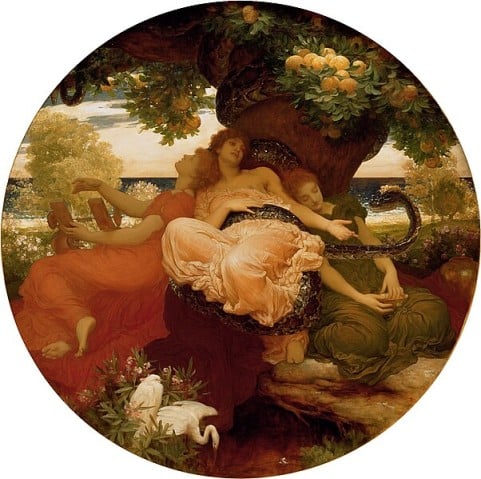
Typically portrayed as beautiful young maidens, the Hesperides bask in the soft glow of the evening light. The evening’s tranquility and beauty reflect through their calm and graceful demeanor. Often, illustrations depict them amidst the lush and enchanting scenery of the garden, where the golden apples, symbolizing divine knowledge and fertility, feature prominently. Moreover, their attire, often flowing and delicate, enhances the natural beauty and the serene ambiance of the garden they vigilantly protect.
Powers
Myths subtly hint at the powers of the Hesperides, intertwining them with the enchanting aura of the garden and the divine essence of the golden apples. It is believed that they hold the ability to enchant and bewitch those who venture near the garden. Moreover, this serves as a strong testament to their role as divine guardians. Often, observers perceive the magic of the Hesperides as a protective force. Moreover, they act as a gentle yet firm barrier between the mortal world and the sacred treasures they guard, showcasing a delicate balance of allure and deterrence.
Their depiction, both in appearance and powers, reflects a harmonious blend of natural beauty and divine essence. Through their guardianship of the golden apples, the Hesperides bring forth the theme of protection of the sacred, embodying a serene yet potent aspect of the divine in Greek mythology.
Hesperides Roles And Responsibilities
The primary role of the Hesperides was to guard the golden apples in the garden entrusted to them. This duty was of significant importance as the apples were not mere fruits, but held divine essence.
Their responsibility showcases a broader theme in Greek mythology, where guardianship of divine or sacred entities is a revered duty. The Hesperides, through their unwavering commitment to protecting the golden apples, embody the essence of loyalty, duty, and the preservation of the sacred.
Their role as guardians also places them in a unique position within the mythological narrative. They are interacting with both gods and heroes, becoming integral parts of stories that have transcended time.
Myths about Hesperides
The mythology surrounding the Hesperides is deeply intertwined with the narrative of the golden apples they were entrusted to guard. These apples were not mere fruits, but divine entities that held immense value and power. The most celebrated myth involving the Hesperides is the tale of Heracles’ eleventh labor. That story not only showcases the hero’s valor but also the mystical allure of the golden apples.
Heracles and the Golden Apples
Heracles eleventh labor, set by King Eurystheus, was to retrieve the golden apples from the garden of the Hesperides. This task was deemed near impossible due to the garden’s remote location as well as the formidable dragon Ladon. It laid coiled around the tree bearing the golden apples, ensuring their safety from intruders. The Hesperides, as the guardians of these divine fruits, played a crucial role in this narrative.
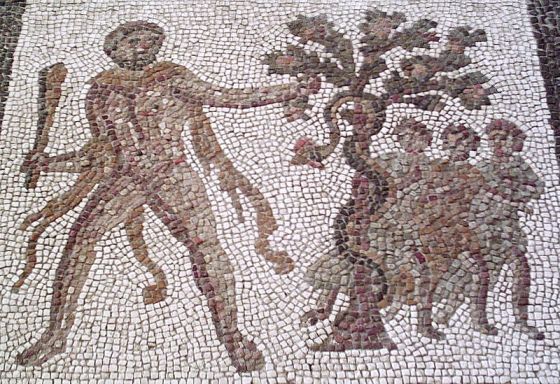
Heracles, undeterred by the challenges that lay ahead, embarked on a perilous journey to the garden of the Hesperides. His adventure was fraught with trials and encounters with various beings, including the giant Antaeus and the seer Phineus. Through these interactions, Heracles gathered the knowledge needed to reach the garden.
Heracles arriving at the garden of the Hesperides
Upon arriving at the garden, two challenges immediately confronted Heracles. Firstly, he needed to bypass the vigilant dragon Ladon, and secondly, overcome the Hesperides to reach the golden apples. In some versions of the myth, it’s said that Heracles charmed the Hesperides with his music. However, transitioning to another version, he tricked Atlas, believed to be the father of the Hesperides, into retrieving the apples for him.
The narrative of Heracles and the golden apples showcases a blend of cunning, strength, and the hero’s indomitable spirit. His interaction with the Hesperides, whether through charm or subterfuge, highlights the delicate balance between mortal endeavor and divine entities. The Hesperides, through their guardianship of the golden apples, represent a threshold between the known and the unknown. Moreover, they are guarding a bridge between the mortal and the divine, adding a layer of mystique to the myth.
Representations Of Hesperides In Art
The Hesperides have been a popular subject in art, especially during the Renaissance period.
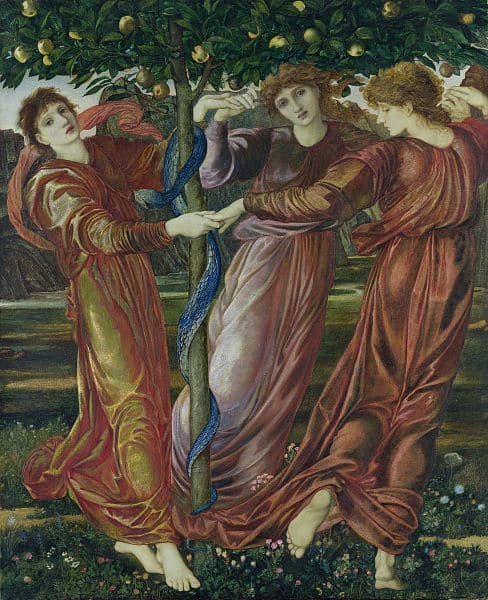
Their depiction often explores themes of beauty, duty, and the ephemeral nature of time, as represented by the evening. The Hesperides, through their ethereal beauty and the mystique of the golden apples, continue to inspire and captivate even today.
Mentions in Ancient Texts
The Hesperides, with their ethereal charm and divine duty, have found mentions in various ancient texts.
Hesiod’s “Theogony”
Hesiod was a Greek poet believed to have been active between 750 and 650 BC. His work “Theogony,” written around 700 BC, is a seminal in Greek mythology. It discusses the origins and genealogies of all the Greek gods. In it, Hesiod also mentions the Hesperides as daughters of Night (Nyx). Moreover he states that they are dwelling near the lofty Atlas mountains, guarding the golden apples in their beautiful garden.
“And Night (Nyx) bore hateful Doom (Moros) and black Fate (Ker) and Death (Thanatos), and she bore Sleep (Hypnos) and the tribe of Dreams (Oneiroi). And again the goddess murky Night, though she lay with none, bare Blame (Momos) and painful Woe (Oizys), and the Hesperides who guard the rich, golden apples and the trees bearing fruit beyond glorious Ocean.”
Apollonius Rhodius’ “Argonautica”
Apollonius Rhodius, an ancient Greek author and librarian who lived in the 3rd century BC, penned the epic poem “Argonautica.” This work, written around 250 BC, narrates the adventures of Jason and the Argonauts in their quest for the Golden Fleece. In “Argonautica,” the Hesperides are mentioned in the context of the perilous journey the heroes undertake, and the divine realms they encounter.
Homer’s “Odyssey”
Homer, author of the epic poems the “Iliad” and the “Odyssey,” mentions a garden of the Hesperides in the “Odyssey,” written around the 8th century BC. Though the mention is brief, it reflects the enduring allure of the Hesperides and their garden in Greek mythology.
“He [Heracles] said he had been sent by Zeus to fetch the hell-hound—for no one else could have done it—and had also dragged up the Hesperides from the Underworld…”
Frequently Asked Questions
The Hesperides lived in “The Garden of the Hesperides,” a distant garden located at the edge of the world.
The golden apples were divine fruits that held magical properties, providing immortality.
The Hesperides are primarily believed to be the daughters of Nyx, the personification of night. However, some sources suggest that they might be the offspring of Zeus and Themis.
The Hesperides are not known for any romantic relationships or offspring. Their narrative primarily revolves around their duty as guardians of the golden apples.
The Hesperides embody the themes of guardianship and the ephemeral nature of time as well as the interaction between mortal beings and divine entities.
Featured Image Credit: Ricciardo Meacci, Public domain, via Wikimedia Commons

